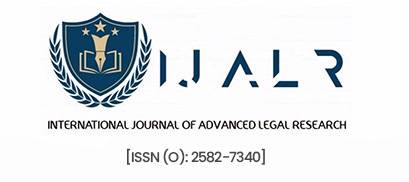Abstract
In today’s interconnected world, organised crime and terrorism are no longer separate threats. They often collaborate and benefit from each other’s strengths, especially in war-torn or conflict-ridden countries where law and order have broken down. Criminal and terrorist groups exploit weak governments, poverty, and fear to grow stronger. This article, “Dark Alliances: Organised Crime and Terrorism in the Shadow of War”, explores the growing connection between transnational organised crime (TOC), terrorism, and war, revealing how these threats are deeply linked and influence one another. In conflict zones, these groups support each other with logistics, training, and finances, forming a “crime-terror nexus”.
The study explains how this nexus has evolved, particularly after the Cold War, when terrorist groups lost state sponsorship and turned to crime for survival. These alliances have become harder to detect as both operate like global businessesstructured and highly adaptable. War and conflict zones provide an ideal environment for them to thrive. When governments collapse or lose control, law and order break down. In such situations, desperate and vulnerable people become easy targets. Terrorist and criminal groups exploit this by offering money, protection, and a sense of purpose.
The article also examines how this crime-terror partnership threatens national and international security by weakening governments, increasing violence, and fuelling long-term instability. Case studies from India and Israel-Palestine highlight the real-world consequences.
Despite several international laws and treaties, current legal frameworks are not fully equipped to address this complex threat. Many laws treat terrorism and organised crime separately, even though they are often part of the same problem. The study calls for reforms in national and international policies to recognise this connection and enhance inter-country cooperation.Finally, it recommends a multi-layered approachto address the existing flaws in the legal system.
As the world is becoming more interconnected, there has also been an increase in organised crimes across the globe on an international scale. These crimes are termed Transnational Organised Crime. They are defined as “An illicit business that transcends cultural, social, linguistic and geographical boundaries and one that knows no borders or rules,” by the United Nations Office on Drugs and Crimes.[1]
TOC not only affect the immediate victims of crime but also broader societal structures. The illegal trade in arms results in conflicts and fuels violence in vulnerable regions, while human trafficking, especially that of women and children, becomes one of the biggest causes of severe human rights violations[2]. As per the Global Organised Crime Index 2023, the frameworks put in place to counter the rise in criminality have failed, and 83% of the population is now under conditions of severe criminality. This becomes a strong indicator of the need for more informed, practical strategies to combat organised crime globally. However, to prepare for the same, there arises a need to identify and understand the background and the ultimate goal of such an organisation.[3]
On the other hand, recent observations have shown that there is a rise in efforts to combat international terrorism. Still, the rise of the Taliban in Afghanistan and other prominent terrorist groups and organisations operating across the globe highlights how global dynamics are still unable to combat such groups.Thereexist huge gaps which have to be filled to address the root of the problem. This requires one to question the intent behind why such groups desire control and how international politics and warfare further contribute togiving free and easy passage for the terror groups to access the vulnerable groups of the nations. Finally, not only does it posea threat to international security, but it also becomes the biggest factor contributing to human rights violations.
Terrorism results in multiple threats which includingorganised terrorism in conflict zones, foreign terrorist fighters, radicalised ‘lone wolves’, and attacks using chemical, biological, radiological, nuclear and explosive materials.Terrorist groups often are seen to target younger individuals to leave their communities and travel to conflict areas to serve their “purposes”,and the way these people are targeted and radicalised has shifted towards social media and other digital platforms,which also leads to widespread reach to these groups.[4]Over 90% of terrorist attacks and 98% of terrorism deaths in 2023 occurred in conflict zones, underscoring the strong link between conflict and terrorism.[5]Conflict remains the primary driver of terrorism, with more than 99 per cent of all terrorist-related deaths occurring in countries involved in a violent conflict or with high levels of political terrorism. [6]
This and many other incidents across time havehighlighted that there is a need to analyse the nexus between terrorism, war (or conflict zones) and TOC to formulate better legislations and adjudication systems to prevent such casualties, human rights violations and prevent terror organisations from gaining power and becoming state actors (leaving the citizens to recourse to access justice).
The purpose of this study is to explore the interconnections between Transnational Organised Crime, terrorism, and warfare, with a focus on understanding how these elements intersect and reinforce one another in contemporary global conflicts. By examining their overlapping networks, financial mechanisms, and operational strategies, the study aims to uncover the complex relationships that enable these actors to thrive. Additionally, the study seeks to assess the broader implications of these interconnections on global security dynamics, including the challenges they pose to national sovereignty, law enforcement, and international peacekeeping efforts. Through this analysis, the study intends to contribute to more informed policy responses and strategic frameworks to counter these multifaceted threats.
[1] UNODC, UNODC Support to the Implementation of the UNTOC (UNODC, 2023) https://www.unodc.org accessed 18 April 2025.
[2]White House, ‘Transnational Organized Crime: A Growing Threat to National and International Security’ (Obama White House Archives, n.d.) https://obamawhitehouse.archives.gov/administration/eop/nsc/transnational-crime/threat
[3]Global Initiative Against Transnational Organized Crime, The Organized Crime Index 2023 (2023) https://globalinitiative.net/analysis/ocindex-2023/
[4]INTERPOL, ‘Terrorism’ https://www.interpol.int/en/Crimes/Terrorism
[5]Vision of Humanity, ‘Global Terrorism Index’ https://www.visionofhumanity.org/maps/global-terrorism-index/#/
[6]United Nations, A New Era of Conflict and Violence (UN75 Report) https://www.un.org/en/un75/climate-crisis-race-we-can-win

